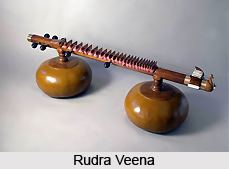 Rudra Veena is an extremely prestigious stringed instrument, held in a lofty position by many since time immemorial. The Vedas mention the usage of the Rudra Veena and it can be witnessed in several excellent sculptural works of temples in the country. The instrument finds usage of its counterparts in the South Indian musical arena. One gathers information that the Rudra Veena had evolved from the Lord Shiva, gazing in overwhelmed admiration at Parvati. The specialty of this stringed genius is that it only such an instance that has the widest ranges of octaves and, as a result an extensive range of tonal improvisations. According to maestros, it is a perfect amalgamation of feminine wonder and masculine gravity. India has seen some of the legendary beenkars to overtake the heights of sublimity, Ustad Wazir Khan and Ustad Bade Ali Khan.
Rudra Veena is an extremely prestigious stringed instrument, held in a lofty position by many since time immemorial. The Vedas mention the usage of the Rudra Veena and it can be witnessed in several excellent sculptural works of temples in the country. The instrument finds usage of its counterparts in the South Indian musical arena. One gathers information that the Rudra Veena had evolved from the Lord Shiva, gazing in overwhelmed admiration at Parvati. The specialty of this stringed genius is that it only such an instance that has the widest ranges of octaves and, as a result an extensive range of tonal improvisations. According to maestros, it is a perfect amalgamation of feminine wonder and masculine gravity. India has seen some of the legendary beenkars to overtake the heights of sublimity, Ustad Wazir Khan and Ustad Bade Ali Khan.Musicians regard the Rudra Veena to be the mother of all Indian stringed instruments. Vedic writings, literary and philosophical works of ancient India abound with references to the veena. Variations of the present-day Rudra Veena can be seen in the sculptures of the temples at Sanchi, Amaravati, Nagarjunakonda, Ellora and Mahabalipuram. There are scholars who hold that the Rudra Veena's prototype was the Kinnara veena. Numerous variations of the Veena existed in different regions in the country at different periods of time, in diverse shapes and with varying numbers of strings. But, in the present times, there exist only a few types of veena all of which produce different tonalities and are also different in shape. The Rudra Veena and Vichitra Veena are the two types known in the north; while the Saraswati Veena and the Vichitra Veena, also called gottuvadyamlchitra veena, are used in the Carnatic tradition.
Several poetic images were coined to describe the beauty of the Rudra Veena. Of these, the loveliest one says that the instrument originated when Rudra Shiva gazed in awe and wonder at the marvellous form of Parvati. When he emerged out of this wondrous contemplation, he supposedly gave the world an instrument that resembled his consort's form. Perhaps it is for this reason instrument is called Rudra Veena. The tone of the Rudra Veena brims with the masculine grandeur of the meditating Shiva. In fact, it is the most masculine sounding of all the Indian instruments. The Rudra Veena maestro Ustad Asad Ali Khan believes that, tonally, the instrument is a confluence of masculine gravity and feminine softness, giving it thus an ardhanareeshwara (androgynous) bhava. Stringed instruments like the sitar and the surbahar originate from it.
Design of Rudra Veena
The instrument consists of a stem approximately three feet long that supports the fret-board made of bamboo on which frets are fixed by means of wax. The bridge of the veena is made of ivory or horn and at the two ends are two large resonators (tumbas), made from gourd, which give the instrument the deep resonant bass effect. These technical features alone make it the only Indian instrument with a vast tonal range, ranging from as high as four to four-and-a-half octaves. The instrument has four melody strings on which the raaga is played. The auxiliary strings suspended on the sides of the instrument provide the drone (chikari) and rhythm (laraj). The melody strings are plucked by the index and middle fingers of the right had using a metallic plectrum or mijrab while the two little fingers play the drone. The index and the middle fingers of the left hand stop the strings over the frets. Rudra vainiks or beenkars sit in the vajrasana posture or the darbari baithak with the upper resonator resting on the left shoulder and the lower one by the right waistline. A few players hold the instrument sitting on the cross-legged posture with the instrument held in a horizontal manner. The latter position is, predominantly adopted only in the South Indian tradition.
For more, visit the link below: